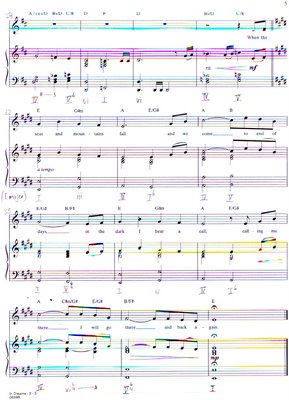Continuity and unity achieve through harmonic, melodic and phrase treatment
An interesting point I observed is that most cadences in this piece occur from the strong to weak beat instead of the usual weak to strong beat, such as seen in bar 10 (plagal cadence), bar 12 (imperfect cadence) etc. This actually reduced the effect of cadential punctuation, injecting in the music a sense of continuous flow.
I also observed how the composer juxtaposes contrasting feelings in the same phrase.
In the main theme (see bars 9-12), the melodic idea felt calm and lyrical. Judging by the balanced and symmetrical melodic contour, a sense of closure is somehow felt. But the subtle usage of imperfect cadence (bar 12) injects a sense of incompleteness to this closure, spurring the music on as the tension for resolution is heightened.
Sometimes the embedded harmonic progressions also underline a certain melodic idea. For example in bar 17, the harmonic progression vi(6)–V(6/4)–vi(6/4) of D major [where its base notes are also D – E – F sharp] actually underlines or echoes the motif D – E – F sharp from the theme with rhythmic augmentation.
Another interesting aspect in bar 18-19, as seen in the bass progression, D–E–F sharp–E, underlying vi6-V(6/4)-vi(6/4)-V progression, the note ‘E’ has the tendency to resolve onto ‘D’ (chord I), but the composer proceed to a ‘G’ (chord IV) instead. Probably by prolonging this resolution to tonic, the music is equipped with some harmonic tension to portray the mood - that of restlessness above tranquility in the piece. It is also rare for chord V to precede chord IV, well at least not in the usual Classical music that we hear.
Fluidity in texture also contributed in giving the music a sense of continuous flow. This fluidity is in some way achieved by how one phrase relates to another. For instance in bar 25, phase overlapping occurs – where the closure of the first subject phrase is overlapped by the introduction of an agitated second subject.
Functional harmony
An interesting point I observed is that most cadences in this piece occur from the strong to weak beat instead of the usual weak to strong beat, such as seen in bar 10 (plagal cadence), bar 12 (imperfect cadence) etc. This actually reduced the effect of cadential punctuation, injecting in the music a sense of continuous flow.
I also observed how the composer juxtaposes contrasting feelings in the same phrase.
In the main theme (see bars 9-12), the melodic idea felt calm and lyrical. Judging by the balanced and symmetrical melodic contour, a sense of closure is somehow felt. But the subtle usage of imperfect cadence (bar 12) injects a sense of incompleteness to this closure, spurring the music on as the tension for resolution is heightened.
Sometimes the embedded harmonic progressions also underline a certain melodic idea. For example in bar 17, the harmonic progression vi(6)–V(6/4)–vi(6/4) of D major [where its base notes are also D – E – F sharp] actually underlines or echoes the motif D – E – F sharp from the theme with rhythmic augmentation.
Another interesting aspect in bar 18-19, as seen in the bass progression, D–E–F sharp–E, underlying vi6-V(6/4)-vi(6/4)-V progression, the note ‘E’ has the tendency to resolve onto ‘D’ (chord I), but the composer proceed to a ‘G’ (chord IV) instead. Probably by prolonging this resolution to tonic, the music is equipped with some harmonic tension to portray the mood - that of restlessness above tranquility in the piece. It is also rare for chord V to precede chord IV, well at least not in the usual Classical music that we hear.
Fluidity in texture also contributed in giving the music a sense of continuous flow. This fluidity is in some way achieved by how one phrase relates to another. For instance in bar 25, phase overlapping occurs – where the closure of the first subject phrase is overlapped by the introduction of an agitated second subject.
Functional harmony
The harmonic functions as observed in this piece generally adhere to our Classical definitions. As seen in the first subject bars 9 – 10, the functional harmonic analysis is T. (b. 9 to 10), P.D. (b. 11 beat 1-2), D. (b.11 beat 3-4), T. (b. 12). In the second subject phrase, the functional harmony is T. (b. 25 to 26), P.D. (b. 27 -31 beat 2), D. (b.31 beat 3-4).
Scores:


